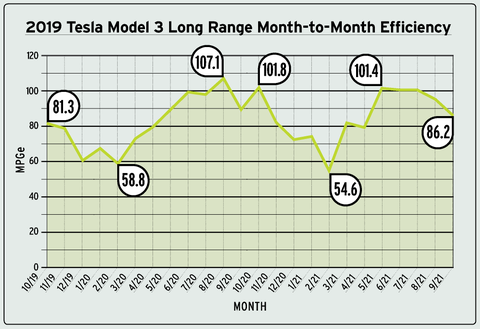Our 2019 Tesla Model 3’s Efficiency Varied Widely Month to Month

Michael SimariCar and Driver
Using third-party software TeslaFi we were able to track our long-term 2019 Tesla Model 3’s average efficiency each month during its two-year test. Its most efficient month was in August 2020 when the average temperature was 79 degrees Fahrenheit, and we averaged 107 MPGe, just under the EPA’s 116-MPGe combined rating. The least efficient month was in February 2021 when the average temperature was 27 degrees and we averaged 55 MPGe.
Welcome to Car and Driver’s Testing Hub, where we zoom in on the test numbers. We’ve been pushing vehicles to their limits since 1956 to provide objective data to bolster our subjective impressions (you can see how we test here). A more comprehensive review of the 2019 Tesla Model 3 Long Range can be found here.
A 40,000-mile long-term test reveals a lot about a vehicle, and our 2019 Model 3 was especially exciting. We track everything from charging to maintenance, and, thanks to third-party software TeslaFi, we were also able to track even more of our car’s data over its two-year stay with us. One thing that stood out was its efficiency each month, which showed how much climate affects an electric vehicle—especially in northern states.
Our Midnight Silver Model 3 Long Range Dual Motor arrived at our Ann Arbor, Michigan headquarters in October of 2019, and as it entered its first frigid northern winter our average efficiency immediately started to decline. In the first month, the car’s average was 81 MPGe, but the worst we saw during our first year was in February 2020 when the average temperature was 31 degrees. We averaged 59 MPGe over 1075 miles of driving, which is just 48 percent of the EPA’s combined rating. The following February, which had an even colder average temp of 27 degrees, our efficiency dipped to its lowest point: 55 MPGe.

Car and Driver
The battery drains far more quickly when parked in cold weather, as energy is used to keep the pack from getting too frigid. Charging is less efficient, too. And cranking up the heat in the cabin and using the heated seats also hurts efficiency. Our long-term test car used a resistive heater, but newer Model 3s get a more efficient heat pump that was introduced for the 2021 model year. In a prior test, our car consumed about 26 percent more energy traveling at 70 mph with the heat on full blast and all five seat heaters on than with the climate control switched off. However, during a test inspired by recent cold-weather traffic jams, we found that when it’s sitting, the Model 3 can theoretically keep its cabin at 65 degrees for a maximum of 45.1 hours in subfreezing temperatures.
Unsurprisingly, our average efficiency improved drastically as the weather started warming up, and we averaged around 100 MPGe during the summer. Our best month was in August 2020, when the temperature averaged 79 degrees and the Tesla achieved 107 MPGe.
Overall, our observed efficiency came out to 83 MPGe, which is 72 percent of the EPA’s aforementioned rating for the 2019 Model 3 Long Range Dual Motor. Another thing TeslaFi revealed, however, is that our battery lost six percent of its capacity over 40,000 miles. And remember: internal combustion efficiency varies with climate, too, but at a much smaller scale.
This content is created and maintained by a third party, and imported onto this page to help users provide their email addresses. You may be able to find more information about this and similar content at piano.io






